- Preventive Measures to Safeguard Your Raspberry Harvest
- 1. Proper Garden Sanitation
- 2. Crop Rotation
- 3. Natural Predators
- 4. Physical Barriers
- 5. Organic Pest Control
- Identifying and Eliminating Raspberry Sawflies
- Identification:
- Life Cycle:
- Control Methods:
- Prevention:
- Controlling Raspberry Moths and Their Damage
- 1. Monitor and Identify
- 2. Use Pheromone Traps
- 3. Apply Biological Controls
- 4. Practice Sanitation
- 5. Consider Insecticides
- Managing Raspberry Fruitworms for a Healthy Crop
- 1. Monitor the Population
- 2. Clean Up Fallen Berries and Debris
- 3. Implement Biological Control
- 4. Use Insecticides Responsibly
- 5. Rotate Crops
- 6. Maintain Good Garden Hygiene
- 7. Trap and Monitor Adult Fruitworms
- Defending Your Raspberry Plants Against Cane Borers
- Identifying Cane Borers
- Preventing Cane Borers
- Controlling Cane Borers
- Combating Raspberry Crown Borers for Optimal Yield
- 1. Regular Inspections and Monitoring
- 2. Physical Removal
- 3. Trapping
- 4. Biological Controls
- 5. Chemical Control
- Effective Methods to Eradicate Spotted Wing Drosophila
- 1. Monitoring and Trapping
- 2. Sanitation
- 3. Cultural Controls
- 4. Protective Netting
- 5. Insecticides
- Natural Remedies to Protect Your Raspberries from Nematodes
- 1. Crop Rotation
- 2. Marigold Companion Planting
- 3. Soil Solarization
- 4. Organic Soil Amendments
- 5. Nematode-Resistant Raspberry Varieties
- Question-answer:
- How can I protect my raspberry crop from wormy pests?
- What are the most common wormy pests that can affect raspberry plants?
- What are the signs of a raspberry fruitworm infestation?
- How can I prevent raspberry fruitworm infestations?
- What are the signs of a raspberry crown borer infestation?
- How can I control a raspberry crown borer infestation?
- What are the signs of a raspberry cane borer infestation?
- Video: Unveiling the Secret to Protect Black Raspberry Crops from Birds
Raspberries are a delicious and nutritious fruit that can be enjoyed fresh or used in a variety of culinary creations. However, these delectable berries are not immune to pests and diseases that can wreak havoc on your crop. In this article, we will discuss how to protect your raspberry plants from five common wormy pests.
One of the most common wormy pests that can infest raspberry plants is the Raspberry Beetle. These small, black beetles feed on the leaves and fruit of raspberry plants, causing damage and reducing the quality of the crop. To control this pest, it is important to regularly inspect your plants and remove any beetles that you find. You can also use pheromone traps to attract and capture the beetles, preventing them from laying eggs and multiplying.
Another pesky worm that can cause damage to your raspberry plants is the Raspberry Sawfly. These green, caterpillar-like worms feed on the leaves of raspberry plants, skeletonizing them and reducing their ability to photosynthesize. To deter sawflies from infesting your plants, you can spray them with a solution of neem oil and water. Additionally, you can introduce natural predators such as parasitic wasps, which will help keep the sawfly population under control.
The Raspberry Crown Borer is another wormy pest that can cause extensive damage to your raspberry plants. These larvae tunnel into the base of raspberry canes, weakening them and making them more susceptible to disease. To prevent infestation, it is important to keep your raspberry patch clean and free from plant debris, as this can attract the adult moths that lay the eggs. If you do notice signs of infestation, you can prune and destroy the affected canes to limit the damage.
The Spotted Wing Drosophila is a small fruit fly that can lay eggs in ripe raspberries, causing them to become soft and mushy. To protect your crop, it is important to harvest ripe raspberries regularly and refrigerate them immediately to kill any eggs or larvae that may be present. You can also use sticky traps to capture adult flies and reduce their population.
Last but not least, the Raspberry Bud Moth is a destructive pest that can infest raspberry buds, causing them to dry up and fail to produce fruit. To control this pest, it is important to prune and remove any infested buds before they open. You can also spray your plants with an insecticidal soap to deter the moths from laying their eggs.
By taking proactive measures to protect your raspberry plants from these five wormy pests, you can ensure a healthy and bountiful crop of raspberries for years to come. Remember to inspect your plants regularly, use natural deterrents and introduce beneficial insects to keep these pests at bay. With a little bit of care and attention, you can enjoy the sweet rewards of a successful raspberry harvest.
Preventive Measures to Safeguard Your Raspberry Harvest
Protecting your raspberry crop from wormy pests is essential to ensure a healthy and plentiful harvest. By taking preventive measures, you can safeguard your raspberries and avoid potential damage. Here are some effective strategies to consider:
1. Proper Garden Sanitation
Begin by maintaining a clean and well-maintained garden environment. Remove any fallen leaves, debris, or decaying plant matter that could serve as a breeding ground for pests.
Tips:
- Rake up fallen leaves regularly to prevent pests from finding shelter.
- Prune any dead or diseased raspberry canes and dispose of them properly.
- Keep the area around your raspberry plants weed-free to eliminate hiding spots for pests.
2. Crop Rotation
Implementing crop rotation is an effective technique to break the lifecycle of pest populations. Avoid planting raspberries in the same area for consecutive years to reduce the chances of pests and diseases.
Tips:
- Rotate your raspberry plants with different crops like beans, peas, or lettuce to disrupt pest cycles.
- Avoid planting raspberries near other susceptible plants, such as strawberries or roses, that can attract common pests.
3. Natural Predators
Encouraging natural predators in your garden can significantly reduce pest populations. Beneficial insects like ladybugs, lacewings, and parasitic wasps are known to feed on harmful pests.
Tips:
- Plant flowers like marigolds, yarrow, and daisies to attract beneficial insects.
- Consider installing bird feeders to attract insect-eating birds like bluebirds or chickadees.
- Create a welcoming habitat for beneficial insects by providing water sources and shelter.
4. Physical Barriers
Use physical barriers to prevent pests from reaching your raspberry plants. This can be particularly effective against flying insects and larger pests like birds.
Tips:
- Install fine mesh netting or row covers over your raspberry plants to keep out insects and birds.
- Use scare devices like reflective tape or wind chimes to deter birds and other animals from approaching your raspberry crop.
5. Organic Pest Control
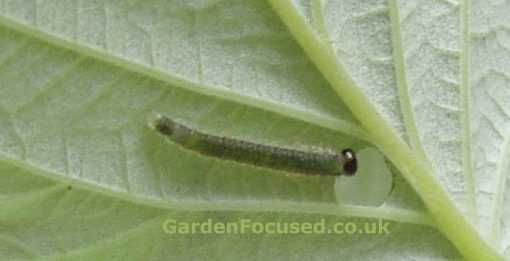
Consider using organic pest control methods to treat potential infestations without harming the environment or beneficial insects.
Tips:
- Apply organic insecticidal soap or neem oil to control common pests like aphids or mites.
- Use bacillus thuringiensis (Bt) to target specific caterpillar pests without harming beneficial insects.
- Introduce nematodes to the soil to control soil-dwelling pests like root maggots.
By implementing these preventive measures, you can protect your raspberry crop from wormy pests and ensure a successful harvest of delicious, healthy berries!
Identifying and Eliminating Raspberry Sawflies
Raspberry sawflies are a common pest that can cause significant damage to raspberry plants. In order to effectively deal with these worms, it is important to be able to identify them and take appropriate action.
Identification:
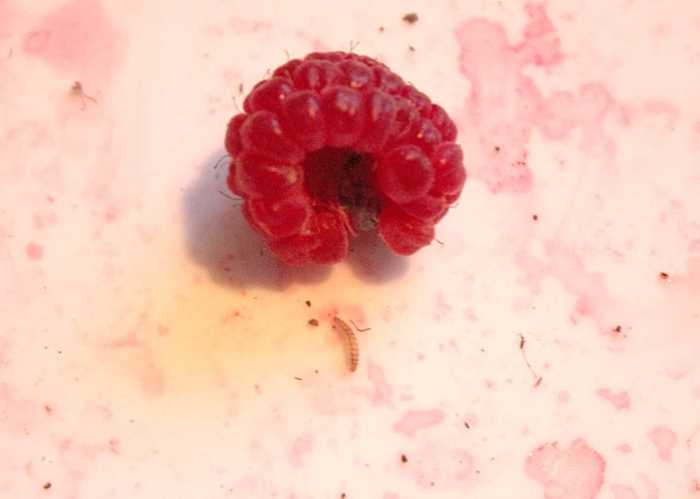
Raspberry sawfly larvae are small green worms that have a slimy appearance and can reach a length of up to 1 inch. They have a distinctive head with a pair of black spots. Adult sawflies are black and yellow, and they resemble wasps.
Life Cycle:
The life cycle of the raspberry sawfly starts when the adult sawflies lay eggs on the underside of raspberry leaves in late spring. The eggs hatch into larvae in about two weeks, and these larvae then proceed to feed on the foliage and berries of the raspberry plants. After about a month, the larvae pupate in the soil and emerge as adult sawflies in mid-summer.
Control Methods:
There are several methods that can be used to control raspberry sawflies:
- Handpicking: Inspect the raspberry plants regularly and remove any sawflies that are found. This can be done by handpicking the worms and dropping them into a bucket of soapy water.
- Pruning: If you notice that the infestation is localized, you can prune the affected branches to remove the sawfly larvae.
- Insecticides: Insecticides can be used as a last resort if the infestation is severe. Make sure to choose an insecticide that is specifically formulated for sawflies and follow the instructions carefully.
- Attracting natural predators: Encourage natural predators of sawflies, such as birds and beneficial insects, by providing habitats and food sources for them in your garden.
Prevention:
Preventing an infestation of raspberry sawflies is always preferable to dealing with an established one. Here are some preventive measures you can take:
- Cleanliness: Keep the area around your raspberry plants clean and free of debris, as this can attract sawflies.
- Proper pruning: Prune your raspberry plants regularly to promote good airflow and reduce the risk of infestation.
- Row covers: Use row covers to protect your raspberry plants from adult sawflies and prevent them from laying eggs on the leaves.
- Companion planting: Planting companion plants such as marigolds, chives, or garlic around your raspberry plants can help deter sawflies.
By being able to identify raspberry sawflies and taking appropriate action, you can protect your raspberry crop from these pesky worms and ensure a bountiful harvest.
Controlling Raspberry Moths and Their Damage
Raspberry moths can cause significant damage to raspberry plants if left untreated. These pests lay their eggs on the fruit and leaves, and the larvae feed on the plant tissues, causing wilting and reduced fruit yield. Here are some methods to control raspberry moths and minimize their damage to your crop:
1. Monitor and Identify
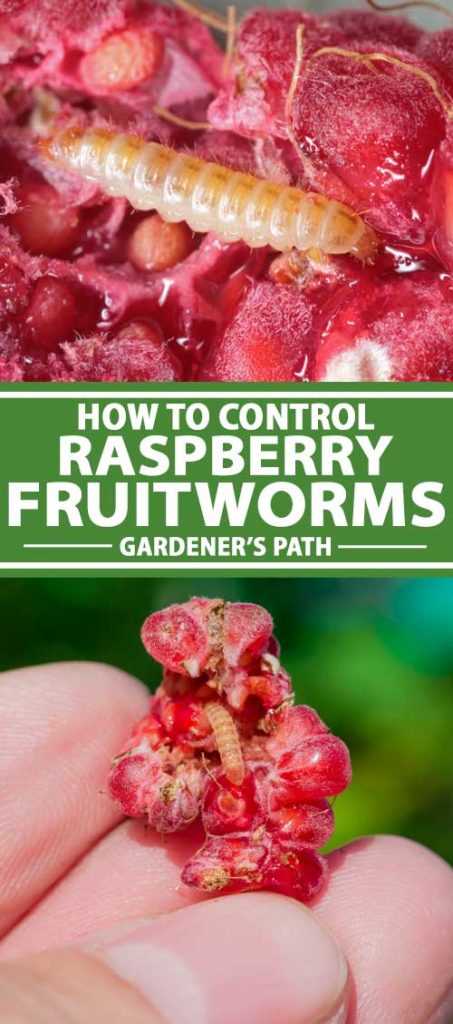
Regularly inspect your raspberry plants for signs of raspberry moth activity. Look for small holes or entry points on the fruit and leaves, as well as webbing or frass (insect excrement). Identifying the presence of raspberry moths early on will help you take appropriate control measures.
2. Use Pheromone Traps
Pheromone traps are effective in catching male raspberry moths, disrupting their mating cycle. By placing these traps near your raspberry plants, you can reduce the number of adult moths and thus decrease the chances of egg-laying. Follow the instructions provided with the traps for optimal placement and use.
3. Apply Biological Controls
Introduce natural predators and parasites of raspberry moths to your garden. Beneficial insects like Trichogramma wasps and lacewings feed on moth eggs and larvae, helping to control their population. You can purchase and release these beneficial insects in your raspberry patch to combat the moth infestation.
4. Practice Sanitation
Maintain good garden hygiene by removing fallen leaves, fruit, and plant debris regularly. Dispose of infested plant materials away from your raspberry patch to prevent reinfestation. This step helps reduce the number of overwintering sites for raspberry moths.
5. Consider Insecticides
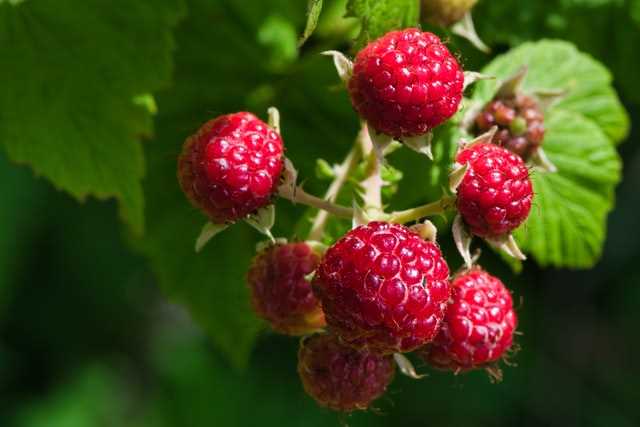
If all other methods fail to control raspberry moths adequately, you might consider using insecticides as a last resort. Choose insecticides labeled for use on raspberries and follow the instructions carefully. Apply the insecticide during the recommended period and avoid using it when the plants are flowering to protect pollinators.
By implementing these control measures, you can effectively manage raspberry moth populations and protect your raspberry crop from their damage. Regular monitoring and preventive actions are key to keeping your plants healthy and productive.
Remember: Always read and follow the instructions on pesticide labels, and consider consulting local agricultural extension offices for specific guidance on raspberry moth control in your area.
Managing Raspberry Fruitworms for a Healthy Crop
Raspberry fruitworms can be a nuisance to raspberry plants, causing damage to the fruits and reducing the overall yield of the crop. However, with proper management and monitoring, it is possible to reduce the impact of these pests and maintain a healthy crop. Here are some strategies to help you manage raspberry fruitworms:
1. Monitor the Population
Regularly monitor your raspberry plants for signs of fruitworms. Look for small holes in the berries, larvae or moths on the plants, or frass (insect excrement) around the berries. Early detection can help you take action before the infestation becomes widespread.
2. Clean Up Fallen Berries and Debris
Ensure that you remove any fallen berries or debris from your raspberry plants. Fruitworms can hide in the fallen fruits or debris and continue to infest the plants. Proper sanitation can help reduce the population of fruitworms.
3. Implement Biological Control
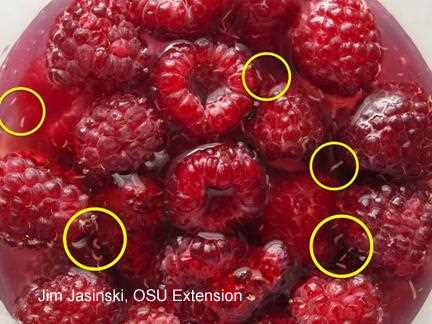
Consider introducing natural predators or parasitic wasps that feed on raspberry fruitworms. These beneficial insects can help control the population of fruitworms in your raspberry patch. Consult with a local agricultural extension office for guidance on the best biological control options for your region.
4. Use Insecticides Responsibly
If necessary, use insecticides to manage raspberry fruitworms. However, be sure to choose a product that specifically targets fruitworms and follow the instructions on the label. Apply the insecticide when the fruitworms are most susceptible, usually during the egg-laying period.
5. Rotate Crops
Practice crop rotation to prevent the buildup of fruitworm populations. Avoid planting raspberries in the same area for multiple years in a row, as this can increase the risk of fruitworm infestations. Instead, rotate raspberries with other crops to disrupt the life cycle of the pests.
6. Maintain Good Garden Hygiene
Keep your raspberry patch clean and tidy to minimize hiding places for fruitworms. Prune the plants regularly to improve air circulation and remove any infected or damaged branches. Additionally, remove any weeds around the raspberry plants, as they can also serve as hosts for fruitworms.
7. Trap and Monitor Adult Fruitworms
Set up traps to monitor and capture adult fruitworms. Use commercially available traps or make homemade traps using yellow sticky cards or sticky traps coated with a suitable attractant. Monitoring the adult population can help you determine the severity of the infestation and the effectiveness of your control measures.
By implementing these management strategies, you can protect your raspberry crop from fruitworms and ensure a healthy and productive harvest.
Defending Your Raspberry Plants Against Cane Borers
Raspberry cane borers are a common pest that can cause serious damage to your raspberry plants. These insects lay their eggs on the canes of raspberry plants, and when the eggs hatch, the larvae bore into the canes, feeding on the inner tissue. This can weaken the canes and lead to stunted growth and decreased fruit production.
Identifying Cane Borers
It is important to be able to identify cane borers so that you can take appropriate action. Adult cane borers are wasp-like insects with black bodies and yellow or orange markings. They are typically about 1/2 inch long. The larvae are creamy-white with dark heads and can be found inside the canes.
Preventing Cane Borers
Prevention is key when it comes to dealing with cane borers. Here are some steps you can take to protect your raspberry plants:
- Keep your raspberry plants healthy and well-maintained. Healthy plants are less susceptible to pests.
- Prune out and destroy any infested canes. This will help prevent the borers from spreading.
- Use sticky traps to catch adult cane borers. These traps can be hung near your raspberry plants to help reduce their population.
- Cover the base of your raspberry plants with a layer of mulch to deter the adult cane borers from laying their eggs.
- Consider using row covers to protect your plants from adult cane borers. These covers can be placed over the plants and provide a physical barrier to the pests.
Controlling Cane Borers
If you already have cane borers infesting your raspberry plants, there are steps you can take to control the population:
- Prune out and destroy infested canes as soon as you notice them. This will help prevent the borers from spreading further.
- Apply an insecticide to the canes according to the product’s instructions. Be sure to choose an insecticide that is labeled for use on raspberries and follow all safety precautions.
- Consider using beneficial nematodes to control the larval stage of the cane borers. These microscopic worms can be applied to the soil around your plants and will seek out and attack the larvae.
- Monitor your plants regularly for signs of cane borer activity and take action as soon as you spot any.
| Method | Effectiveness |
|---|---|
| Keeping plants healthy | High |
| Pruning infested canes | High |
| Using sticky traps | Medium |
| Applying mulch | Medium |
| Using row covers | Medium |
| Applying insecticide | High |
| Using beneficial nematodes | Medium |
| Regular monitoring | High |
By taking preventive measures and promptly addressing any infestations, you can protect your raspberry plants from the damage caused by cane borers and ensure a healthy and productive crop.
Combating Raspberry Crown Borers for Optimal Yield
Raspberry crown borers are a common pest that can wreak havoc on your raspberry crop if left untreated. These destructive insects burrow into the crown and roots of the raspberry plants, causing weakened growth, reduced yield, and even plant death. Fortunately, there are several methods you can employ to combat raspberry crown borers and protect your crop.
1. Regular Inspections and Monitoring
The first step in managing raspberry crown borers is to regularly inspect your plants for any signs of infestation. Look for wilting, yellowing leaves, stunted growth, or holes in the crown or stems. Additionally, monitor for adult borers, which are reddish-brown moths that fly around the plants during the day.
2. Physical Removal
If you spot any signs of infestation, it is crucial to physically remove the affected plants as soon as possible. Carefully dig up the plants, inspect the crown and roots for borers, and promptly destroy any infested plants. Be sure to dispose of the plants away from your raspberry patch to prevent further spread of the borers.
3. Trapping
Using traps can be an effective way to catch adult raspberry crown borers before they have a chance to lay eggs. Yellow sticky traps can attract and capture the moths, preventing them from infesting additional plants. Place the traps near your raspberry patch and regularly check and replace them as needed.
4. Biological Controls
Natural enemies of raspberry crown borers, such as certain parasitic wasps, can help keep their populations in check. These beneficial insects lay their eggs on the borer larvae, which then hatch and consume the borers. You can encourage the presence of these natural enemies by providing habitat and food sources, such as flowers and native plants, in your garden.
5. Chemical Control
If the infestation is severe or other methods have not provided effective control, you may need to resort to chemical controls. Insecticides labeled for raspberry crown borer control can be applied to the base of the plants according to the manufacturer’s instructions. However, it is important to use these pesticides judiciously and follow all safety precautions.
By implementing these strategies and staying vigilant, you can combat raspberry crown borers and ensure optimal yield from your raspberry crop. Regular inspections, physical removal of infested plants, trapping, encouraging natural enemies, and, if necessary, using chemical control can help protect your raspberries and keep them healthy and productive.
Effective Methods to Eradicate Spotted Wing Drosophila
Spotted Wing Drosophila (SWD) is a major threat to raspberry crops, as the larvae can cause severe damage to the fruits. In order to protect your raspberry crop, it is essential to implement effective methods to eradicate these pests. Here are some strategies you can use:
1. Monitoring and Trapping
Regular monitoring is crucial for early detection of SWD infestations. Set up traps using vinegar-based baits to attract and capture adult flies. By regularly checking the traps, you can determine the presence and level of infestation.
2. Sanitation
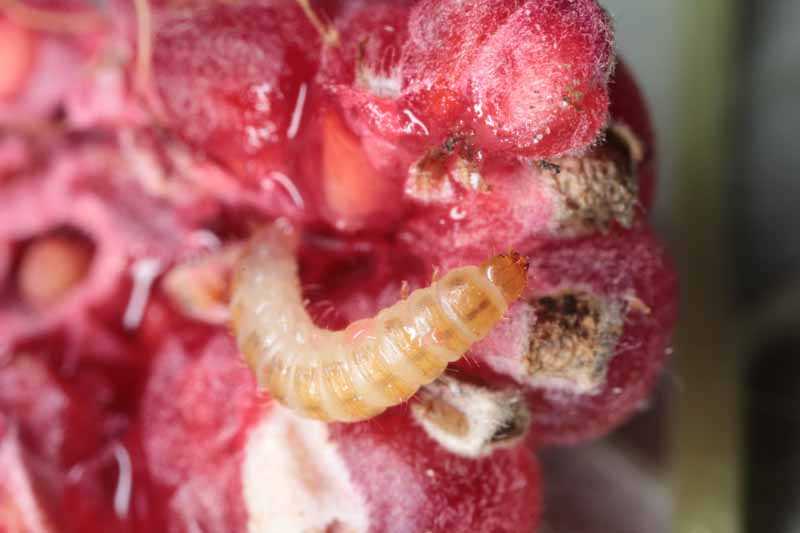
Good sanitation practices in and around the raspberry plants can help reduce SWD populations. Remove and destroy overripe, damaged, or infested fruits to eliminate potential breeding grounds for the flies. Also, remove fallen fruits from the ground to prevent larvae from completing their life cycle.
3. Cultural Controls
Implement cultural controls to manage SWD infestations. Pruning raspberry plants to improve airflow can make it harder for the flies to locate the fruits. Additionally, planting early-maturing or late-maturing raspberry varieties can help avoid peak SWD activity periods.
4. Protective Netting
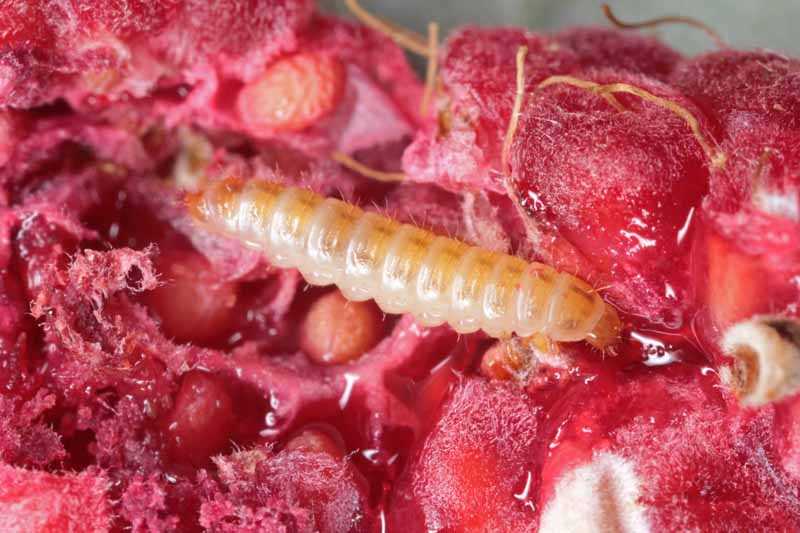
Use fine-mesh netting to cover raspberry plants and create a physical barrier that prevents SWD from accessing the fruits. This method is highly effective in preventing infestations, but proper installation and maintenance are necessary for optimum results.
5. Insecticides
As a last resort, insecticides can be used to control SWD infestations. Consult with local agricultural extension services or a professional to choose the appropriate insecticide and use it according to the label instructions. Be cautious when using insecticides as they can have negative effects on beneficial insects and pollinators.
By combining these methods and implementing an integrated pest management approach, you can effectively eradicate Spotted Wing Drosophila and protect your raspberry crop from significant damage.
Natural Remedies to Protect Your Raspberries from Nematodes
Nematodes are microscopic worms that can cause significant damage to raspberry plants. They invade the roots and feed on the plant tissues, leading to stunted growth and decreased fruit production. Fortunately, there are several natural remedies that can help protect your raspberries from nematode infestation.
1. Crop Rotation
One effective method to control nematode populations is through crop rotation. Avoid planting raspberries and other susceptible plants in the same location year after year. Instead, rotate your crops, planting non-host plants such as beans or corn in between raspberry seasons. This helps break the nematode life cycle and reduces the risk of infestation.
2. Marigold Companion Planting
Marigolds are known to repel nematodes with their potent root exudates. Interplanting marigolds with raspberry bushes can help deter nematodes from invading the roots. Choose French marigolds (Tagetes patula) or Mexican marigolds (Tagetes erecta) for the best results. Plant marigolds in between raspberry rows or create a border around the raspberry patch.
3. Soil Solarization
Soil solarization is a method of using the sun’s heat to kill nematodes and other pests in the soil. Begin by preparing the raspberry bed as usual, then cover the entire area with a clear plastic tarp. Secure the edges of the tarp to the ground to create a seal. Leave the tarp in place for 4 to 6 weeks during the hottest months of the year. The heat trapped under the tarp will effectively eradicate nematodes and other soilborne pests.
4. Organic Soil Amendments
Adding organic amendments to the soil can improve its health and make it less hospitable to nematodes. Incorporate well-rotted compost, aged manure, or other organic matter into the soil before planting raspberries. These amendments not only provide essential nutrients for plant growth but also help support beneficial microorganisms that compete with nematodes for food and space.
5. Nematode-Resistant Raspberry Varieties
Planting nematode-resistant raspberry varieties is another proactive approach to protect your crop. Look for raspberry cultivars that are labeled as “nematode-resistant” or “tolerant” when purchasing plants. These varieties have been bred specifically to withstand nematode attacks and are less susceptible to infestation.
By implementing these natural remedies, you can help protect your raspberry plants from nematode damage and ensure a healthy and productive crop. Remember to combine these strategies to maximize their effectiveness and enjoy a bountiful raspberry harvest.
Question-answer:
How can I protect my raspberry crop from wormy pests?
There are several effective strategies to protect your raspberry crop from wormy pests. One method is to regularly inspect your plants for signs of infestation and manually remove any worms you find. Another option is to use natural predators, such as beneficial nematodes or ladybugs, to control the pest population. Additionally, you can apply organic insecticides, such as neem oil or diatomaceous earth, to deter and kill the pests. Finally, maintaining good garden hygiene, such as removing fallen leaves and pruning infected branches, can help reduce the risk of infestation.
What are the most common wormy pests that can affect raspberry plants?
There are five common wormy pests that can affect raspberry plants. These include the raspberry fruitworm, the raspberry crown borer, the raspberry cane borer, the raspberry sawfly, and the raspberry cane maggot. Each pest has its own unique characteristics and damage patterns, but they all can cause significant harm to raspberry plants if left untreated.
What are the signs of a raspberry fruitworm infestation?
A raspberry fruitworm infestation can be identified by several signs. The most common one is the presence of small, white worms inside the ripe berries. You may also notice small holes or tunnels on the surface of the berries, as well as chewed leaves and flowers. If you see any of these signs, it’s important to take immediate action to control the infestation and protect your crop.
How can I prevent raspberry fruitworm infestations?
Preventing raspberry fruitworm infestations requires a combination of proactive measures. First, you can use floating row covers to physically block the adult fruitworms from laying their eggs on the plants. Additionally, applying insecticides specifically targeted at fruitworm control can help keep the population in check. Lastly, maintaining good garden hygiene, such as removing fallen berries and weeds, can help reduce the risk of infestation.
What are the signs of a raspberry crown borer infestation?
A raspberry crown borer infestation can be identified by several signs. One common sign is wilting or yellowing of the leaves, especially in the lower part of the plant. You may also observe sawdust-like frass near the base of the plants or notice tunnels or holes in the canes. If you notice any of these symptoms, it’s important to take immediate action to control the infestation and save your raspberry crop.
How can I control a raspberry crown borer infestation?
Controlling a raspberry crown borer infestation can be challenging, but there are several strategies you can try. First, you can cut out and destroy the affected canes to remove the larvae and prevent further damage. Applying insecticides specifically designed for borer control can also be effective, but it’s important to follow the instructions carefully. Finally, maintaining good garden hygiene, such as removing fallen canes and pruning infected areas, can help reduce the risk of infestation.
What are the signs of a raspberry cane borer infestation?
A raspberry cane borer infestation can be identified by several signs. One common sign is wilting or yellowing of the leaves, especially in the upper part of the plant. You may also observe sawdust-like frass near the base of the plants or notice tunnels or holes in the canes. If you notice any of these symptoms, it’s important to take immediate action to control the infestation and save your raspberry crop.







